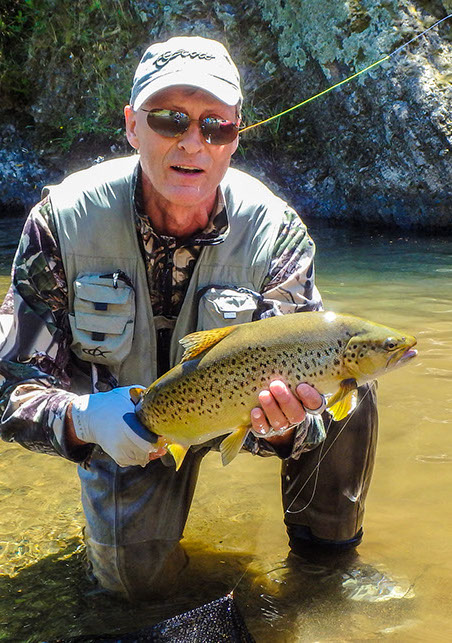The Mohaka and its tributaries contain both rainbow and brown trout which reach up to 10 lb or more on occasion. More typically, fish are in the 4 to 6 lb range but they are all strong resident fish due to their fast-flowing river habitat. Fish can be spotted in slower stretches but in faster water blind fishing potential lies is the usual technique.
A Fish & Game New Zealand licence is required: this allows fishing throughout New Zealand apart from the Taupo region for which a separate Department of Conservation license is needed.
Fly and spin fishing are the permitted methods. Fly fishers can choose between ‘traditional’ nymphing, Czech nymphing or, in the deeper pools, wet lining with streamer flies. 5 or 6 wt rods are typically used.
The Mohaka is open all year but tributaries open on 1 October and close on 30 June. (Refer to the current F&GNZ Sports Fishing Regulations, Hawkes Bay Region.)
Opportunities for Anglers
Trips can be organised to suit your preferences and the time available. You can choose from trips ranging from a half day to 10 days, or somewhere in between. The highest point on the Mohaka headwaters with road access for our rafts is the hot spring area at Mangatutu.
The Waipunga can be rafted from the Waipunga Falls to its confluence with Mohaka.
Most anglers, however, elect to drift that part of the Mohaka from the bridge on Pakaututu Road – inland from Puketiritiri – back to our base on McVicars Road, near the SH5 bridge. This gives access to 18 km of river that has no other access points for the public. Each of 1 or 2 rafts can take up to 4 anglers plus a rafting guide.
Getting to the put-in place at Pakaututu Bridge involves a 90 minute mini-bus drive, with the rafts in tow, through the beautiful Hawkes Bay back country, or a 10 minute helicopter flight. At the river, anglers can fish in the vicinity for the 30 minutes or so needed to set up the rafts, and then it’s off on a peaceful drift, with the anglers paddling from time to time. The rafts stop at those stretches of the river that provide reasonable fishing water for all on board.
This trip can be done in one day or two. There are two good places to camp near the halfway point. The two day option involves transporting more equipment and anglers’ gear – tents, cooking stuff, food, sleeping bags and so forth – on the rafts but it is a more leisurely trip. A one day trip, on the other hand is full on – an early start is needed and even then some good looking water will be left untouched.
Studded wading boots will damage our rafts and cannot therefore be worn: we recommend the use of a wading staff to increase safety while wading.


Auckland angler Mark Norton with a 6 pound Brown Trout.
Pakaututu Bridge. Click on this image to view on Google Maps. Image © Google Maps.
© 2016 Raft Fish New Zealand